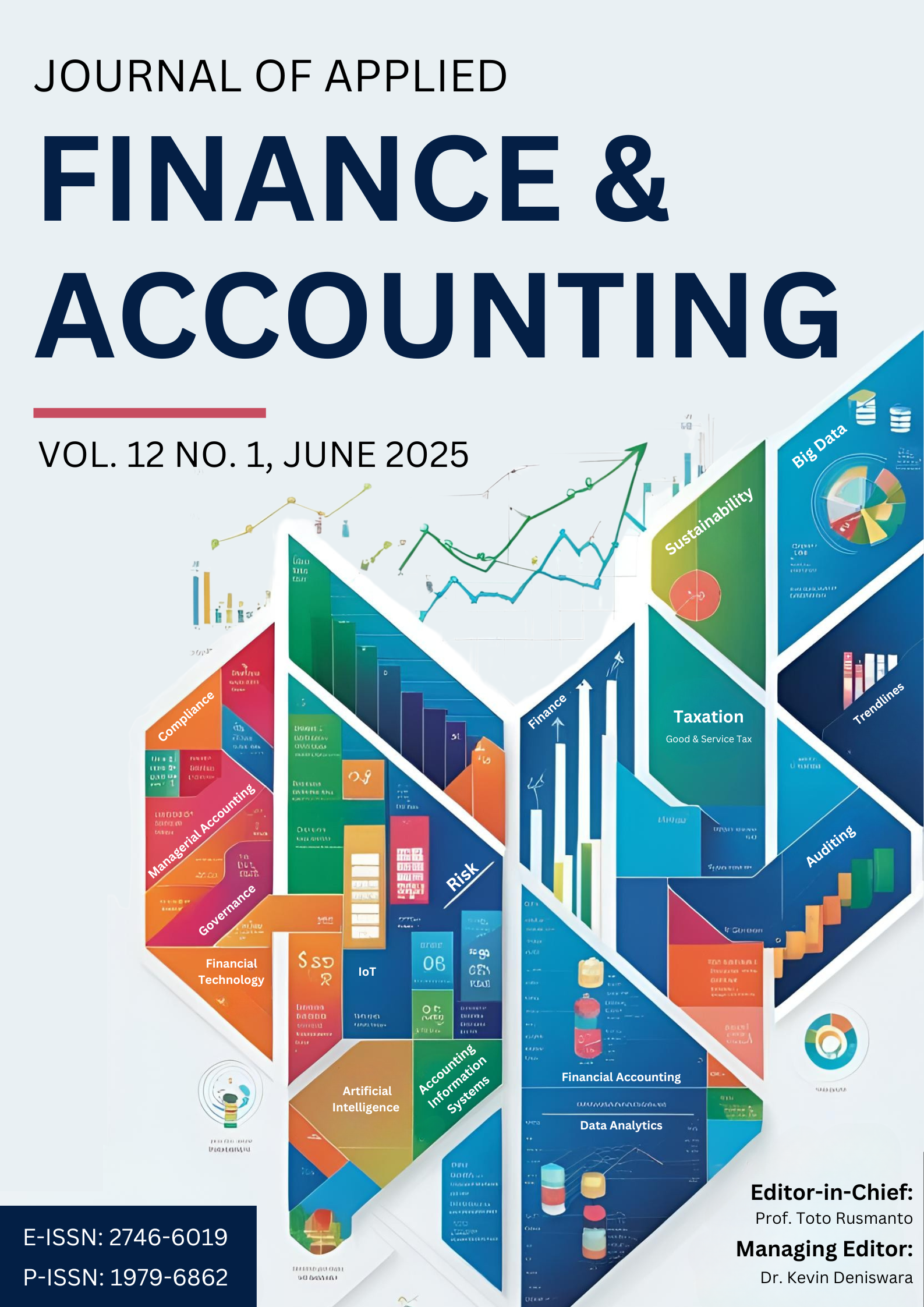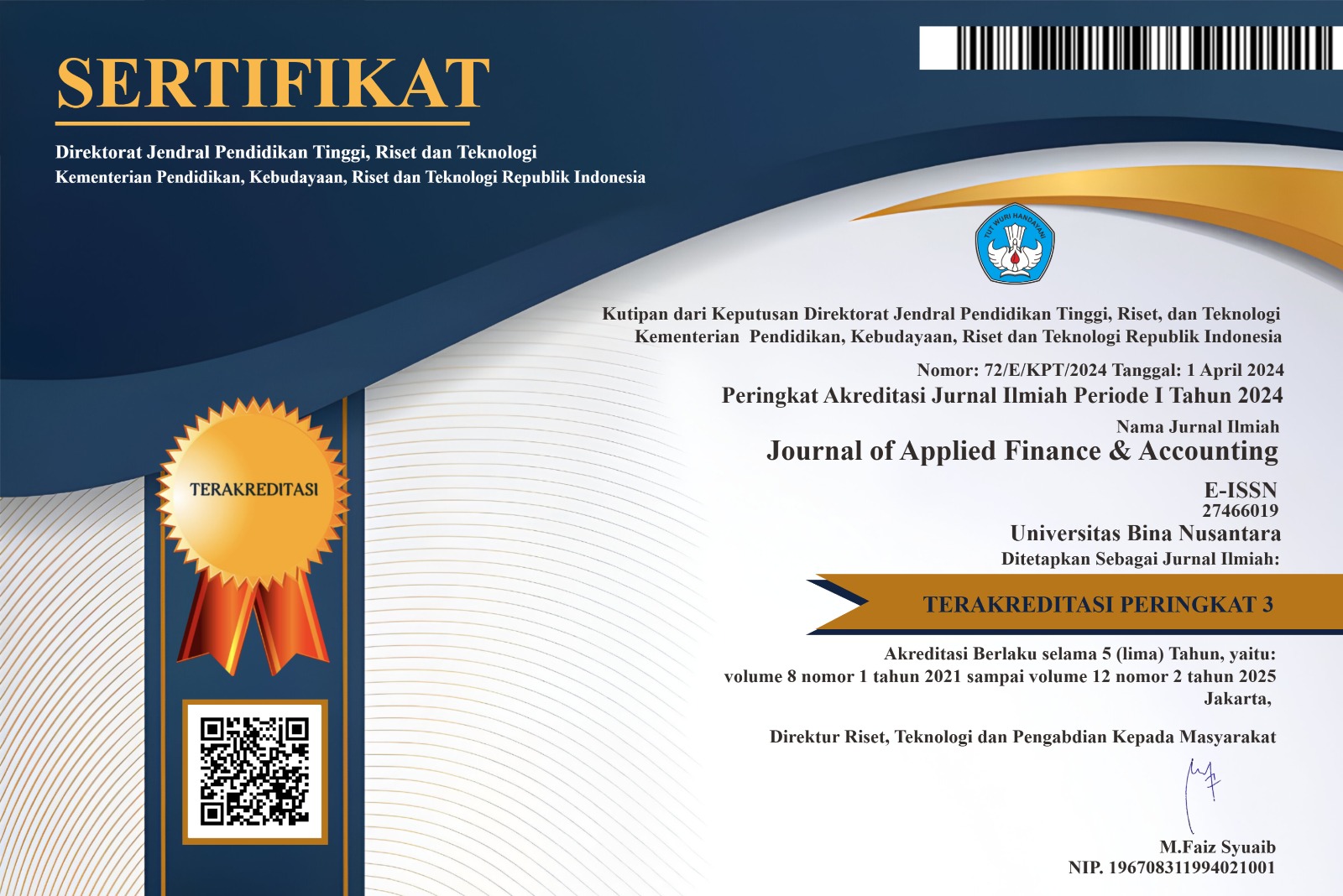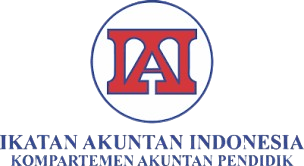IMPACT OF GREEN ACCOUNTING, MATERIAL FLOW COST ACCOUNTING, CAPITAL STRUCTURE ON FINANCIAL PERFORMANCE WITH FIRM DEBT AS MODERATOR
DOI:
https://doi.org/10.21512/jafa.v12i1.13676Keywords:
Green Accounting, Material Flow Cost Accounting, Capital Structure, Financial Performance, Firm DebtAbstract
This study examines the effect of green accounting, material flow cost accounting (MFCA), and capital structure on financial performance, with firm debt as a moderating variable. Using a quantitative approach, the research analyses secondary data from 109 basic materials sector companies listed on the Indonesia Stock Exchange (IDX) for the 2016–2023 period. Data were collected through documentation and analysed using Microsoft Excel and E-Views 12 with panel data regression, including model selection tests, classical assumption tests, and descriptive statistics. T-tests and the coefficient of determination (R²) were employed to assess the significance of each variable. The findings show that green accounting significantly affects financial performance, while MFCA and capital structure do not. Firm debt moderates the relationship between green accounting and financial performance but has no moderating effect on the influence of MFCA and capital structure. Theoretical implications support the view that environmental sustainability, represented by green accounting, contributes to firm value, aligning with stakeholder and legitimacy theories. Companies are encouraged to adopt green accounting as a strategic tool, particularly in environmentally intensive industries, and to consider debt structure to maximise its financial impact. Future research should investigate other sectors or external factors influencing the effectiveness of MFCA and capital structure. Broader samples and mixed methods may also enhance understanding of how environmental and financial strategies interact in corporate settings.
References
Abdullah, M. W. (2020). Ragam Isu dan Konsep Akuntansi Lingkungan Perspektif Keislaman (N. H. Husain, Ed.; 1st ed., Vol. 1). Alauddin University Press UPT Perpustakaan UIN Alauddin Makassar.
Afni, F. N., & Achyani, F. (2023). Pengaruh Green Accounting, Sustainability Report Dan Material Flow Cost Accounting Terhadap Profitability Dengan Intellectual Capital Sebagai Variabel Moderasi. Innovative: Journal Of Social Science Research, 3(5), 2196–2210.
Alfitri, D. N. (2022). The Effect of Environment Performance, Capital Structure, and Company Size on Financial Performance. Maksimum: Media Akuntansi Universitas Muhammadiyah Semarang, 2(2).
Almunawwaroh, M., Deswanto, V., Karlina, E., Firmialy, S. D., Nurfauziah, F. L., & Ilyas, M. (2022). Green Accounting: Akuntansi dan Lingkungan (Y. Welly, Ed.). CV Media Sains Indonesia.
Andriani, C., & Susanto, L. (2021). Faktor-Faktor Yang Memengaruhi Struktur Modal. Jurnal Paradigma Akuntansi, 3(4), 1660–1669.
Angelina, M., & Nursasi, E. (2021). Pengaruh penerapan green accounting dan kinerja lingkungan terhadap kinerja keuangan perusahaan. Jurnal Manajemen Dirgantara, 14(2), 211–224.
Arsyiyanti, N., Ahmar, N., & Mulyadi, J. (2024). Pengaruh Intellectual Capital dan Green Accounting terhadap Financial Performance di Moderasi oleh Strategy Business. Jurnal Greenation Ilmu Akuntansi, 2(2), 1–13.
Arvielda. (2022). Pengaruh Sales Growth, Firm Debt, Liquidity Dan Firm Size Terhadap Financial Performance Pada Perusahaan Manufaktur Di BEI . UniversitasTarumanegara.
Asia Productivity Organization. (2014). Manual on Material Flow Cost Accounting ISO 14051.
Asti. (2021). Pengaruh Penerapan Green Accounting, Pengungkapan Lingkungan dan Material Flow Cost Accounting (MFCA) Terhadap Profitabilitas Perusahaan (Studi Pada Perusahaan Sektor Aneka Industri Yang Terdaftar Di Bursa Efek Indonesia Periode 2015-2019). Jurnal Sistem Informasi, Akuntansi & Manajemen), 1(1), 17–26.
Badan Pusat Statistik. (2024, May 6). Ekonomi Indonesia Triwulan I-2024 Tumbuh 5,11 Persen (Y-on-Y) dan Ekonomi Indonesia Triwulan I-2024 Terkontraksi 0,83 Persen (Q-to-Q). Badan Pusat Statistik. https://www.bps.go.id/id/pressrelease/2024/05/06/2380/ekonomi-indonesia-triwulan-i-2024-tumbuh-5-11-persen--y-on-y--dan-ekonomi-indonesia-triwulan-i-2024-terkontraksi-0-83-persen--q-to-q--.html
Dowling, J., & Pfeffer, J. (1975). Organizational Legitimacy: Social Values and Organizational Behavior. Pacific Sociological Review, 18(1), 122–136. https://doi.org/10.2307/1388226
Faizah, B. S. Q. (2020). Penerapan green accounting terhadap kinerja keuangan. JRAK, 12(2), 94–99.
Fatimah, N., Agustina, Y., & Setiadi, I. (2023). The Effect Of Green Accounting And Material Flow Cost Accounting On Financial Performance. Kurs : Jurnal Akuntansi, Kewirausahaan Dan Bisnis, 8(2).
Freeman, R. E. E., & McVea, J. (2001). A Stakeholder Approach to Strategic Management. SSRN Electronic Journal. https://doi.org/10.2139/ssrn.263511
Fuadah, L. L., Yuliani, & Safitri, H. R. (2018). Pengungkapan Sustainability Reporting di Indonesia (1st ed., Vol. 1). Citrabooks Indonesia.
Gemilang, M. R., & Wiyono, S. (2022). Good Corporate Governance, Struktur Modal, Leverage, Dan Ukuran Perusahaan Terhadap Kinerja Keuangan. Jurnal Ekonomi Trisakti, 2(2), 529–542.
Harsono, A., & Pamungkas, A. S. (2020). Pengaruh Struktur Modal, Likuiditas dan Ukuran Perusahaan terhadap Kinerja Keuangan Perusahaan. Jurnal Manajerial Dan Kewirausahaan, 2(4), 847–854.
ISO. (2021). ISO 14053 - Environmental management – Material flow cost accounting — Guidance for phased implementation in organizations. Committee.Iso.Org. https://committee.iso.org/sites/tc207sc1/home/projects/published/iso-14053--material-flow-cost-ac.html#:~:text=To%20achieve%20SDGs%20Goal%2012,economic%20information%20on%20their%20activity
Kementerian Lingkungan Hidup dan Kehutanan. (2021, August 25). Progres Penanganan Permasalahan Hutan Adat dan Pencemaran Limbah Industri di Danau Toba. Ppid.Menlhk.Go.Id. https://ppid.menlhk.go.id/berita/siaran-pers/6135/progres-penanganan-permasalahan-hutan-adat-dan-pencemaran-limbah-industri-di-danau-toba
Kurniasari, W., & Wibowo, J. (2017). Manajemen Pembiayaan dan Ekuitas (W. Kurniasari, Ed.). Universitas Katolik Soegijapranata.
Mabruroh, & Anwar, S. (2022). Pengaruh Green Accounting, Ukuran Perusahaan, Dan Leverage Terhadap Financial Performance Dengan Nilai Perusahaan Sebagai Variabel Moderasi. COSTING:Journal of Economic, Business and Accounting, 5(2).
Maritza, S., & Wenten, I. K. (2024). Pengaruh Green Accounting dan Capital Structure terhadap Financial Performance dengan Firm Debt sebagai Variabel Moderasi. AKADEMIK: Jurnal Mahasiswa Humanis, 4(3), 983–997.
Myers, S. C. (1984). The Capital Structure Puzzle. The Journal of Finance, 39(3), 574–592. https://doi.org/10.1111/j.1540-6261.1984.tb03646.x
Ningsih, S., & Utami, W. B. (2020). Pengaruh operating leverage dan struktur modal terhadap kinerja keuangan pada perusahaan go publik sektor property dan real estate. Jurnal Akuntansi Dan Pajak, 20(2), 154–160.
Oktadifa, R. M., & Widajantie, T. D. (2024). Pengaruh Penerapan Green Accounting, Material Flow Cost Accounting, dan Environmental Performance terhadap Profitabilitas Perusahaan. Al-Kharaj: Jurnal Ekonomi, Keuangan & Bisnis Syariah, 6(3).
Ramadhani, K., Saputra, M. S., & Wahyuni, L. (2022). Pengaruh Penerapan Green Accounting Dan Kinerja Lingkungan Terhadap Kinerja Keuangan Dengan Tata Kelola Perusahaan Sebagai Variabel Moderasi. Jurnal Akuntansi Trisakti, 9(2).
Redemptus, A., & Susilowati, C. (2024). Dalam Peran Profitabilitas dalam Memoderasi Pengaruh Capital Structure dan Sales Growth terhadap Financial Performance. Jurnal Akuntansi AKUNESA, 12(2), 153–162.
rri.co.id. (2021, July 15). DLHK Sidoarjo Laporkan Limbah PT Tjiwi Kimia ke Kemen LHK. Rri.Co.Id. https://rri.co.id/surabaya/jawa-timur/1115155/dlhk-sidoarjo-laporkan-limbah-pt-tjiwi-kimia-ke-kemen-lhk
Santi, A. R. (2022). Pengaruh Penerapan Material Flow Cost Accounting Terhadap Green Accounting Dan Financial Performance (Studi Empiris Pada Perusahaan Sektor Industri Dasar dan Kimia yang Terdaftar di Bursa Efek Indonesia Tahun 2018-2020.
Sari, S. (2023). Pengaruh Green Accounting, Audit Internal, Dan Struktur Modal Terhadap Kinerja Keuangan (Studi Pada Perusahaan Sektor Energi Dan Pertambangan Yang Terdaftar Di ISSI Periode 2019-2021). Universitas Islam Negeri Raden Intan Lampung.
Sekaran, U. (2017). Metodologi Penelitian.
Siregar, R. H. (2021). Pengaruh Penerapan Green Accounting, Material Flow Cost Accounting, Kepemilikan Manajerial Dan Manajemen Laba Terhadap Kinerja Keuangan Pada Perusahaan Pertambangan. JURNAL NERACA, 2(2), 118–121.
Subroto, V. K., & Endaryati, E. (2023). Kumpulan Teori Akuntansi (I. Yunianto, Ed.; 1st ed., Vol. 1). Yayasan Prima Agus Teknik.
Titisari, K. H. (2020). Up Green CSR Refleksi Edukatif Riset CSR dalam Pengembangan Bisnis (K. B. Setiyawan, Ed.; 1st ed., Vol. 1). CV Kekata Group. chrome-extension://efaidnbmnnnibpcajpcglclefindmkaj/https://repository.uniba.ac.id/766/1/Buku%20Up%20Green%20CSR%2C%20Fina_1202020.pdf
Wardhani, Y. A., & Suwarno, A. E. (2021). Pengaruh Kepemilikan Manajerial, Kepemilikan Institusional, Struktur Modal dan Ukuran Perusahaan terhadap Kinerja Keuangan Perusahaan (Studi Empiris pada Perusahaan Manufaktur yang Terdaftar di Bursa Efek Indonesia Tahun 2017-2019). E-Prosiding Seminar Nasional Manajemen Dan Akuntansi STIE Semarang (SENMAS), 2(1), 315–332.
Downloads
Published
Issue
Section
License
Authors who publish with this journal agree to the following terms:
Authors retain copyright and grant the journal right of first publication with the work simultaneously licensed under a Creative Commons Attribution License that allows others to share the work with an acknowledgement of the work's authorship and initial publication in this journal.
Authors are able to enter into separate, additional contractual arrangements for the non-exclusive distribution of the journal's published version of the work (e.g., post it to an institutional repository or publish it in a book), with an acknowledgement of its initial publication in this journal.
Authors are permitted and encouraged to post their work online (e.g., in institutional repositories or on their website) prior to and during the submission process, as it can lead to productive exchanges, as well as earlier and greater citation of published work (See The Effect of Open Access).





